|
551st
Introduction
Chronology
Roll
of Honor
Insignia of the 551st
Joseph
Edgerly
Belated
Recognition
Return
to Articles
Home
Page
|
|
Panama
The 1st
Battalion, 551st Parachute Infantry Regiment (Reinf.) was
activated 26 November 1942 at Fort Kobbe, Canal Zone.1
No other elements of the Regiment would be activated, and the
unit, which would operate as an independent battalion, is generally
known as the 551st Parachute Infantry Battalion (PIB).2
At the time of its activation, the
battalion consisted of a single company of men from the 501st
PIB. When the 501st left the Canal Zone for Australia (to
become the 2nd Battalion, 503rd PIR), Company C
remained at Fort Kobbe as Company C, 1st Battalion, 551st
PIR.3 At the same time, the balance of
the battalion was forming in the “Frying Pan,” and it is there the
battalion’s story really begins.
The Frying Pan, a part of Fort Benning
separate from the Parachute School, was the home of the Parachute School
Replacement Pool. Although a few of its personnel would be jump trained
in Panama, and a handful would join the unit later in Sicily, the 551st
was formed mainly from graduates of classes 42, 43, and 44 of the First
Parachute Training Regiment at Fort Benning. Each weekend a new class
graduated from the Parachute School, and a portion of the class joined
the growing battalion. In the meantime, life in the Frying Pan consisted
mainly of a rigorous program of physical training.
Sgt. Don Garrigues : “It had more or
less been expected that the battalion would begin scheduling 10-day
furloughs along about this time. This had been pretty much the standard
practice for those who had graduated from jump school. As each day
passed and no furloughs were given, this became the major topic of every
gripe session. It even took precedence over gripes about the food, which
was saying a lot because the food was terrible and seemed to be getting
worse all the time…
“Our hopes for furloughs went down the
drain when, on the morning of December 8th, the entire
battalion was called out for formation in the rain and mud where we were
told by the commanding officer that we would soon be leaving the
continental limits of the United States. The approximately 450 men were
told not to write or send anything home, and we were restricted to the
limits of our area. Later, when we were allowed to write, all of our
outgoing mail was censored.
“We were issued new combat jumpsuits
and steel helmets. The helmets had liners and chin straps specially
designed for parachutists. We stamped and identified each piece of
clothing with the initial of our last name and the last four digits of
our Army serial number. Any man with tattoos had to report to the
medical area where any markings that would identify them as paratroopers
were surgically removed or obliterated with additional tattoos. This was
doubly painful to most of the guys as they had just paid to have them
put on right after graduating from jump school.
“We left Fort Benning on the night of
December 11th , taking one last look at the most predominant
feature there—the parachute training towers. The Southern Railway
provided our transportation.
“…Our troop train traveled through
South Carolina, North Carolina and into Virginia. We passed through
Richmond and ended up at Camp Patrick Henry, which was near Newport
News, arriving there on December 13.”4
While Camp Patrick Henry served as the
port of embarkation, it was, in a practical sense, more of the Frying
Pan. A full training schedule was instituted and camp security was
rigidly enforced. All members of the battalion were restricted to camp.
No one could wear uniforms or special insignia that would identify the
wearer as a paratrooper.
T/5 Dan Morgan: “Something special
happened to us at Camp Patrick Henry. We could not see it then—it was
one of those little things: the addition of ‘Furlough’ to our ranks.
She was a shorthaired dachshund, colored black and tan, and just a pup.
Some of our men took her out of the yard of the port commander, and Jim
Heffernan became her keeper—at risk of court-martial. Furlough would
become one of the everlasting bonds that would hold us together,
brothers in life and death.”5
Pfc Jim Heffernan: “They swiped her out
of somebody's yard. They had been drinking. She couldn't have been but
10 weeks old. I can’t remember who got her. We got to the dock and
started loading. Phil Hammack hid my gas mask in his barracks bag and I
stuffed Furlough in the empty carrier. I left her nose poking out of the
side of it until we started up the gangway, then I pushed her head in
and hoped she wouldn't start squealing. She was discovered but the boat
had left by then. The Colonel said he would take care of everything and
he looked out for her after that...”6
On 27 December, the battalion, with Major
Wood Joerg commanding, left Newport News aboard the troop ship USS
Joseph T. Dickman and sailed for Fort Kobbe, Canal Zone, where it
arrived six days later.
Fort Kobbe was a fairly new facility. Located near the ocean and the
Canal's Miraflores Locks, it boasted a new airfield, Howard Field, as
well as a battery of 18-inch naval guns. For the next eight months, Fort
Kobe would be home for both the 551st and the 550th
Infantry Airborne Battalion. (The 550th Infantry Airborne
Battalion was not a paratrooper unit. Originally intended to be
an air-landed unit, i.e., one that would be flown to, and land on,
captured airfields, the unit was used in combat as glider infantry.)
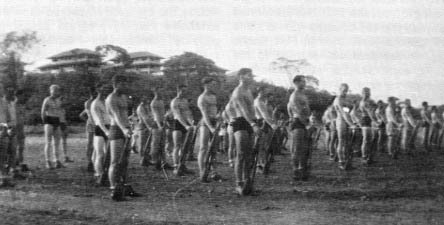
Drilling
in Panama's heat (C. Fairlamb)
Immediately upon the battalion’s
arrival at Fort Kobbe, Major Joerg was confronted with a problem. The
officers of Company C, 501st PIB, who had remained at Kobbe
to be part of the 551st, believing that they were the nucleus
of the new battalion and that those coming from the States to join them
were, in effect, fillers, had set up a complete battalion organization,
from battalion commander on down. Major Joerg, the commanding officer of
the “fillers,” had a different view of the situation. (Joerg would
rise to the rank of Lieutenant Colonel and is referred to as “the
Colonel” by those who served under him.)
T/5 Dan Morgan: “A few serious mistakes
were made at the very outset, the most regrettable of which was probably
the Colonel's negative response to preparations made for him in Panama
by the officers and men of Company C of the 501st Battalion.
This apparent slight may have been caused by feelings of insecurity, for
the Colonel was then only 27 and this was his first overseas command.
The slight feeling of unease that it generated between the 400 of us
newcomers and 125 old guard then at Fort Kobbe was to last until we
returned to the States eight months later. From that point on we were as
one. Unfortunately, as a result of this incident, we lost one very good
and dedicated officer: Bill Hickman. We GOYA's have to remember him
because, in addition to been an outstanding officer, he was technically
the first commanding officer of the 551st.”7
(The respect that Dan Morgan accords William Hickman is noteworthy in
light of the treatment Mr. Hickman receives in Gregory Orfalea’s book.8)
Wood G. Joerg (West Point class of 1937)
was a strict disciplinarian who set high standards of performance for
the Battalion. Respected by the battalion’s officers, although
somewhat aloof from them, he was, in time, revered by the enlisted men.
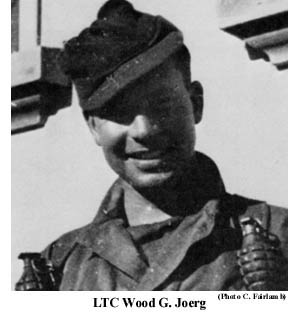
The Colonel was given to calling the men
his “birds.” Someone
applied the Army's penchant for acronyms to one of the Colonel's
favorite expressions, “get off your ass!”, and soon the men were
referring to themselves as “GOYA birds,” or simply GOYAs. The
nickname stuck.
Almost immediately upon arriving at Fort
Kobe, the battalion embarked upon an extensive training program
stressing physical conditioning, weapons proficiency, and, especially,
jungle warfare and survival. The men were issued machetes and learned to
use them for clearing their way through the jungle as well as for
weapons.
The mission of the 550th and
551st at Fort Kobe was to provide a mobile strike force to
protect the Panama Canal, and to deploy, if necessary, to Central
American and Caribbean countries whose governments were at risk of
being overthrown by pro-Nazi factions or that were providing aid and
comfort to the Nazi’s U-Boat activities in the region.9
Security measures were instituted to minimize publicity regarding
the presence of the units and their mission. The men's outgoing mail was
censured to remove any indication of their location or their mission.
The unit's address during this period was simply APO 832, c/o
Postmaster, New Orleans, La.10
But on one occasion it was decided to
publicize the battalion's presence and its combat readiness. Near the
end of its stay in Panama, the battalion was turned out for a special
review in Balboa for the president of Columbia. It was part of an
American psychological warfare effort to destabilize the Vichy
(pro-Nazi) administration governing the French island of Martinique,
where, it was suspected, German U-boats were being resupplied. So
serious was the American concern with Martinique that, on 13 May, the
550th and 551st were put on standby for an
invasion of the island. The psychological pressure generated by the
preparations was enough to topple the Vichy administration of the
island, and the invasion was called off.
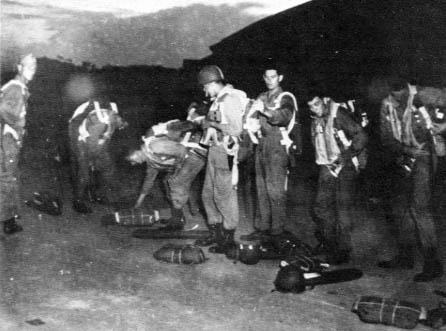
Gearing up for a
practice jump in Panama. (C. Fairlamb)
In July rumors began to circulate that
the battalion would be leaving Fort Kobbe. The rumors proved true, and
on 20 August 1943 both the 550th and 551st boarded
a troop ship and sailed from the Canal Zone. The speculation among the
men was that they were bound for New York and then overseas, but the
ship steamed into the Pacific and headed north. Ten days later, the
battalion disembarked in San Francisco.
The voyage was marked by an incident that
served to enhance the Colonel's popularity with the enlisted men.
Furlough, the battalion's dachshund mascot, was smuggled aboard the
troop ship, but her presence was soon discovered by the crew.
Capt. Ed Hartman: “A crewman, acting on
the orders of the Master-at-Arms, attempted to throw Furlough overboard
in compliance with Army Transport Service regulations, which prohibited
animals accompanying troops. The crewman was immediately surrounded by a
group of very quiet but angry troopers who made him realize that if
Furlough went over the side, so would he.”11
T/5 Dan Morgan: “At this point our
Colonel called on the Master and a face-down and potential mass mutiny
were avoided. Feelings were running high at that moment. It is possible
that if the master of the vessel had attempted to have furlough thrown
over, we would've taken over the ship. We were in no mood for games. So
the Master wisely decided to bide his time until we got to San Francisco
and then turned the matter over to the port authorities. The Colonel
risked a court-martial and the loss of his of command over the incident.
These were the things that marked him as our own.”12
Camp
Mackall
On 3 September, the 550th and
551st boarded troop trains for a five-day cross-country trip
that would take them to their new home, Camp Mackall, North Carolina.
Camp Mackall, a temporary facility for airborne troops, was only eight months old when the 551st arrived.
(Closed in 1945, Camp Mackall today is again active and serves as a site
of US Special Forces training.)
T/5 Dan Morgan: “A few weeks after our
arrival, the Colonel arranged for our battalion to do the first
experimental mass parachute jumps ever made from gliders. Notices
appeared on the Company bulletin board calling for volunteers, and
signature sheets immediately filled to overflowing, for we badly needed
something to do.”13
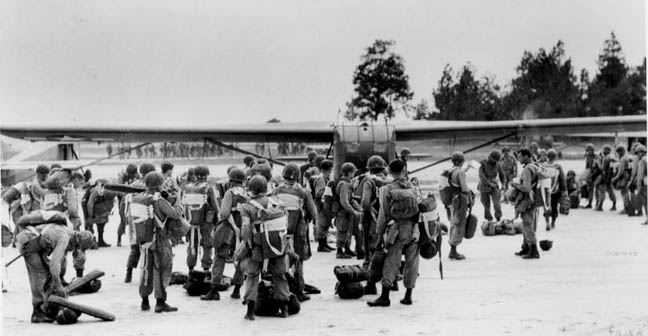
Waiting
to board gliders at Laurinburg-Maxton AAB. (C. Fairlamb)
Major Bill Holm: “Our Battalion
pioneered the technique of snatching a glider, with troops, off the
ground. And, of course, we tested the concept of jumping the battalion
from C-47s and gliders simultaneously, with each C-47 pulling two
gliders. We made a close pattern on the ground.”14
S/Sgt Jim Stevens: “We began making glider jumps. One of the problems
was that we jumped from both doors of a glider. If one stick went out
faster than the other, then the glider tended to heal over on one wing.
It was important that both sides went out at the same time. Also, the
anchor line fasteners and other pieces of hardware used in the gliders
were substandard and would sometimes break loose.”15
(When jumping, the men were organized into groups of about
18 called “sticks.”)
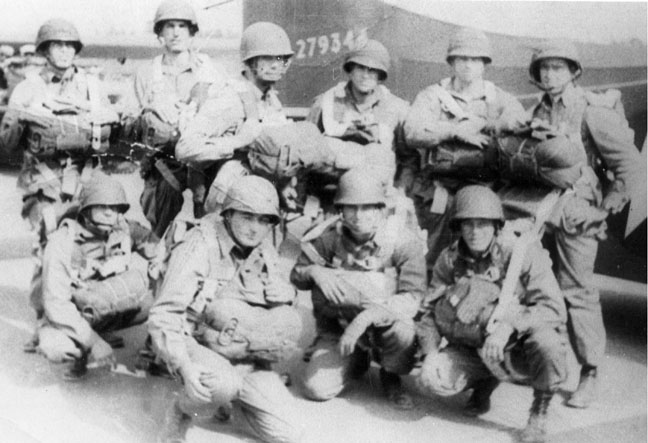
A
pose before
boarding gliders, Camp Mackall.
T/Sgt Bob Van Horrsen: “I heard that
when Sergeant Blaiszik jumped (he was pretty big) he pulled the anchor
line cable right out of the glider with him. I was in that same glider
and he was the last man out.”16
T/5 Dan Morgan: “That happened more
than once. The cable bracket would pull out of the glider from the
bulkhead. Fortunately, the cable bracket U-bolt remained fixed to the
anchor line cable end, thus retaining all the anchor-line snap
fasteners. When these particular gliders landed, the anchor-line cables
were hanging out of their doors with all the static lines bunched at the
end of the cable.”17
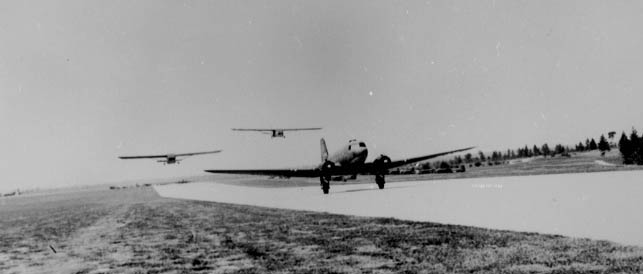
Paratrooper-laden
gliders being towed from Camp Mackall airstrip. (C. Fairlamb)
When the 551st left Fort Kobbe,
it was a highly-trained, combat-ready unit, and it was into combat the
men expected to be sent. Instead, they found themselves at Camp Mackall
in what seemed to be an endless training program. Morale deteriorated,
and to complicate matters, Lt. Col. Joerg left the battalion early in
the fall of 1943 to assume command of the new 542nd PIB, a
unit that was intended to become a regiment. His replacement was Lt.
Col. Rupert D. Graves, a career soldier and West Point graduate (class
of 1925).
As morale continued to deteriorate, the
incidence of AWOLs increased. Rumors began to circulate that the
battalion would be broken up and the men assigned to other airborne
units then at Mackall.
T/5 Dan Morgan: “Colonel Graves decided
to correct our bad attitudes by force. ...One of the unusual after
effects of Colonel Graves's efforts at reconstructing the 551st
has been the dramatic difference in the attitudes towards this
well-intentioned commander of his officers on the one hand, and the men
on the other...
“... the officers' view of Colonel
Graves suggests a very mature, well-intentioned, likable, professional
and tough-minded career officer. From our view he was distant, abusive,
grossly unfair, inept and probably temporary. He had no charisma and
seemed not to care. We could sense the threat we were to his career. We
would have shaped up for him had he asked us in the right way, I think,
but he was in the saddle and that was evidently not his way. Perhaps too
much of the stick and too little of the carrot.”18
A 5-mile run each morning before breakfast was instituted in an effort,
it was believed, to generate sufficient pressure within the ranks to
reduce the AWOL rate. The tactic might have been effective with a new
unit, but the men the 551st were now a close-knit family, and
the resulting hostility was directed a Colonel Graves.19
T/5 Dan Morgan: “In any event, we were
restricted, furloughs were abolished, our noncoms were reduced in rank
and minor infractions were dealt with summarily and harshly. We finally
had over 200 over men in the post stockade.”20
It was during this period the battalion
was notified that it would be making a night jump—its first. Such
training was considered essential because of the belief that daylight
airborne operations in hostile territory would incur unacceptably high
casualty rates.
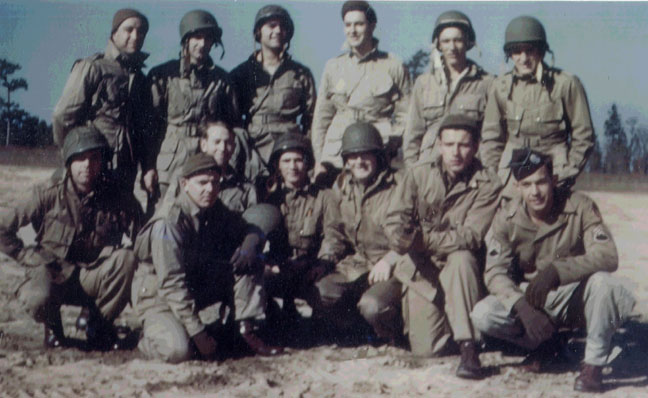
Before
a practice jump, Camp Mackall.
All four companies of the battalion were
to jump simultaneously onto a drop zone 1600 feet wide and 2000 feet
long, bounded on each side by a small lake or reservoir. Control of the
jump was taken from the jumpmasters and given to the pilot or copilot,
who would activate a red light and then a green light, indicating stand-by
and jump.
At 1915 hrs on 16 February, the planes
took off in conditions of light rain and mist. At 2030 hours the
battalion began its jump.
Capt. Ed Hartman: “The Troop Carrier
unit became disoriented during the final approach to the DZ and dropped
the battalion over the western part of North Carolina. A major element
of the drop went into a forested area. There was a lake in the center,
and due to visibility conditions that night, the lake appeared to be the
only cleared area, so the jumpers, as they descended, tried to slip in
that direction.”21
1st Sgt. Bill Lumsden: “Well, we made a
night jump and I was the last man out of the plane. It was a very, very
dark night, and of course, our jump was controlled by the pilot or
copilot. They turned on the switch and we went on the buzzer or light or
whatever. When we jumped you couldn't see anything on the ground at all.
It was absolutely pitch black, so that we were on the ground or in the
water, as the case may be, before anyone could even see what was going
on, so they didn't have a chance to slip out of their chutes. Being the
last man, I landed in fairly shallow water and so I got out OK. So much
of the rest of it is rather sketchy. I remember how terrible it was to
come back to the barracks afterwards and to realize that much of my
platoon was gone.”22
Capt. Jud Chalkey: “It was about day
light when we fished the first body out of the water. He was obviously
dead, but his buddy was there with him. He kept saying, ‘help him Doc,
he ain’t dead.’ I tried
to convince him—rigor mortis had already set in—but he was really
beside himself. We finally got him calmed down somehow. That was a hard
thing to see.”23
T/5 Dan Morgan: “The jump was a sad one
for the battalion, for nine very good troopers were lost, eight of them
being drowned in Reservoir South and one killed on landing. The jump was
made with full combat load, so that the men who hit the reservoir went
right to the bottom. One-man landed in about 7 feet of water and
survived by repeatedly jumping up, gasping a lung full of air and then
taking several steps towards shore along the bottom. At least 40 men
landed in Reservoir South, and it is surprising that the cost was not
higher.”24
S/Sgt Jim Stevens: “At that time we
were probably the oldest airborne unit there at Mackall and they didn't
want the younger men to see the bodies, so we took care of everything
ourselves. We got them all out and buried them with honors.”25
T/5 Dan Morgan: “Drew Pearson, who for
many years wrote a nationally published column called The Washington
Merry-Go-Round, was advised of our
unfortunate drownings at Camp Mackall. Pearson had been pushing for some
time to get the armed services to adopt the British quick-release
parachute harness, and in his column dated 17 April 1944 he noted that
Colonel C. B. Degavre, second in command at Camp Mackall, came to
Washington in March, following our accident. The Colonel's trip was made
in order to secure the procurement of the British type harnesses for the
U.S. Army paratroopers. Thus, it would seem that our men did not die
entirely in vain, for the quick release harness was eventually
adopted.”26 (Modification of the T-5
parachute harness to accommodate a quick-release mechanism did not begin
until after D-Day and appears to have been driven not by this tragedy
but by the experiences of paratroopers who made the Normandy jump.)
On 23 March, Lt. Col. Joerg returned to
take command of the Battalion and Lt. Col. Graves departed. (Graves
would rise to the rank of colonel and command the 517th
PRCT,
which role would again bring him into contact with the 551st.)
Almost immediately upon taking command, Joerg paid a visit to the nearly
200 members of his battalion confined to stockade (nearly all of them
for having gone AWOL). He spoke to the men, ending his brief speech with
a request for a show of hands from those who would pledge on their word
of honor not to go AWOL if allowed to return to the battalion. A few
minutes later, after gathering their belongings, the men marched back to
the battalion.
Italy
The 550th and 551st
boarded Liberty ships and sailed east out of Norfolk on 23 April 1944.
Accompanying the men of the 551st was the battalion's mascot,
Furlough, whose passage had been arranged in advance by Lt. Col. Joerg.
By the end the first week of June, the elements of the battalion had
assembled in Naples.
Shortly
after arriving in
Italy, the battalion underwent a reorganization that converted
Headquarters Company into a heavy weapons company; formed a Headquarters
Detachment from the battalion’s staff and administrative personnel,
and a Service Company Detachment to provide logistical services.27
Initially, the battalion was to join the
fighting at the Anzio beachhead, but rather than boarding a troopship,
the men were loaded into old 40x8 railcars and soon were rolling south
through the Italian countryside, away from the front. The battalion’s
destination was Camp Wright, near Trapani, Sicily, and more training.
(At least one of the 551st veterans recalled that the
battalion was tasked with establishing a jump school at Camp Wright.28
This is an interesting claim, as the Fifth Army had established its jump
school near Trapani, at Camp Kurtz, about six months earlier, and moved
that facility to a location near Rome at about the same time the 551st
relocated to Lido di Roma.29)
Although the battalion did not go to the
Anzio front, one of its members did.
Sgt Bill Hatcher: “Joe Edgerly was an
unforgettable person. After all, how many of us would go AWOL to the
front? Joe was almost a
perfect physical specimen: very muscular, adventuresome, carefree and
gung ho. So when we got to Italy Joe went AWOL from the battalion, I
think while we were in Naples, before we went to Sicily for training. He
was gone a few days, maybe four, and then came back to the battalion. At
this time he was not in Company B so I got to see him less frequently.
The next time I saw him I mentioned that he had done this and I asked
him why. He said he just had to find out what combat was like. He had
gone up to the Fifth Army front. That would have been in early June
1944. To me that is derring-do of the highest order.”30
(Edgerly would be killed in action during the Southern France campaign.)
In Sicily the intensity of the training
increased.
S/Sgt Charlie Fairlamb: “The training
in Sicily was the toughest in the world. They gave us no rest at all.
We would go along on a hot night and they would tell you to empty your
canteen. Then they would put a guard on any available water and make you
hike for eight hours with full load, carrying all equipment, without
water. I can recall lying on the ground trying to get dew off the grass,
but there wasn't any. You couldn't chew gum or anything, it would just
stick. We had pills that would keep you awake for a couple of days—benzedrine—but
I never took any because I figured I might get to a place where I would
be able to sleep.”31
T/5 Jack Affeck: “The training went
along pretty well until they tried an experiment with benzedrine. It was
supposed to make you very alert and give you extra strength. So we took
one pill each and started out on a 20-mile hike. It was just great, and
we were really moving along at a great pace. That was at night, and we
were to go the 20 miles and then go into a simulated assault; however,
by the time we got there the stuff had worn off and everybody was just
completely pooped. I guess they decided the stuff wasn't so great after
all.”32
Major Ray Hermann: “After four weeks in
Sicily, during which we became brown as natives and hard as nails, we
again boarded boxcars and headed for the vicinity of Rome. I missed the
train trip that time, having been chosen to take our small convoy to the
new base. We had two beautiful camps there—first on the shore of Lake
Albano, and then at Lido di Roma, which once was a swanky beach resort
southwest of Rome. We had a hotel there, and a couple of villas on the
beach for quarters. We cleared a path through the German-laid minefields
so we could swim, and we made the occasional trip into Rome. Life was
good. It wasn't all play, of course. It was at Lido that we were told we
were to jump into South France as part of the First Airborne Task Force.
That meant the study of maps and aerial photos, making sand table models
of the area we planned to hit, packing of parachutes and equipment, and
more training with a specific objective in view.”33
Southern
France
After the fall of Sicily in August 1943,
the focus of Allied planning fell on Western Europe. A plan was proposed
that included two invasions of France, one from the north, Operation
OVERLORD, and one from the South, Operation ANVIL. By drawing German
troops away from the north of France, ANVIL would help ensure the
success of OVERLORD.
Before ANVIL could be implemented, it was
first necessary to drive the Germans out of Italy, and that proved to be
a much more protracted undertaking than Allied planners had
envisioned. As a result, ANVIL was scrapped and OVERLORD proceeded as
scheduled but without the aid of a diversionary of invasion of the South
of France.
Soon after the Normandy invasion,
Eisenhower pressed for the invasion of southern France. President
Roosevelt accepted Eisenhower's arguments over the strong dissent of
Churchill, who favored a thrust into the Balkans. Thus was ANVIL, now
codenamed DRAGOON, resurrected.
DRAGOON, scheduled for 15 August 1944,
was to consist of an amphibious landing by three US infantry divisions
(the 3rd, 36th , and 45th) and an
airborne assault by a new division-size force, the First Airborne Task
Force, commanded by Major General Robert T. Frederick and comprising the
British 2nd Independent Parachute Brigade and all the
separate American airborne units in the Mediterranean Theater: the 509th
PIB, 517th PRCT, 550th IAB, and the 551st
PIB. A platoon from the 887th Engineer Company (Glider) was
attached to the 551st for the operation.
Sgt. Don Garrigues: “A unit specially
trained in camouflage work set up camp near our building one day and
began the task of spray painting every jumpsuit and piece of equipment
in colors of green and black. One platoon at a time was taken through
the process, which consisted of placing a box over our heads and being
spray painted all over. Our weapons and equipment were placed to one
side and gone over systematically by two men with spray guns. It was a
hurried job, but the effects were very good.”34
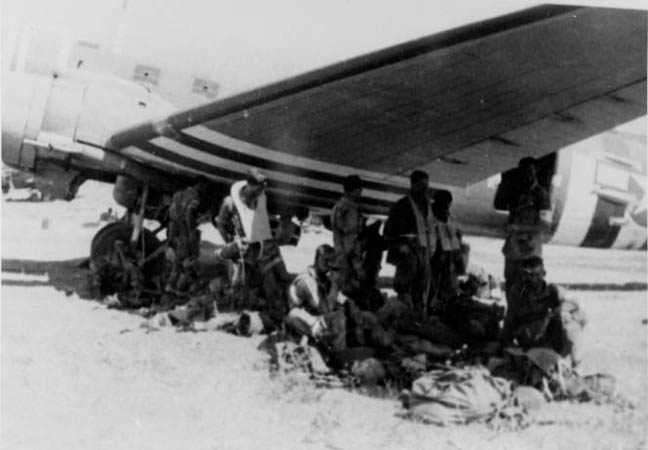
Waiting
to board aircraft for the invasion of southern France. (C. Fairlamb)
Cpl. John “Mel” Clark: “About a
week before South France D-Day we got our clothing, guns and equipment
camouflaged and ready. We left our college there in Lido di Roma by
truck and went to the airfield north of Rome. Then we spent three days
resting up, sleeping, swimming, going to movies and getting the 'big
picture'—aerial photos, sand tables, maps, the works! The Colonel made
sure every man was familiar with the whole operation. His assembly flag
was the flag of the Confederate states. At 1300 we ate a big meal, put
on our war paint, donned our camouflage suits and attached everything
but the kitchen sink to us and walked about a mile to the planes.”35
With the exception of the 551st,
the airborne units of the Task Force (and the pathfinders of the 551st)
parachuted into southern France during the predawn hours of 15 August.
The men of the 551st jumped from their planes over DZ/LZ A,
near Le Motte, at 1809 hrs. The gliders of the 550th soon
followed. (Jumping with the 551st was the Red Cross
representative to the Task Force, David de Varona, whose daughter Donna
would win two swimming gold medals at the 1964 Olympics.)
Capt. Jud Chalkey: “I was jumpmaster of
our stick. It consisted mostly of mortar and bazooka men from Battalion
HQ. The panorama of the invasion as we flew over the beachhead was a
magnificent sight. You could see the assault boats going in and the guys
crawling on the beaches. The battleships were firing and the battle was
in full swing. We were flying at about 2000 feet but you could smell the
cordite. We had just six minutes from the time we got to the shoreline
until we were to jump. We got the red light, the plane dropped down
some, and then lifted as we came in for the drop. So when the green
light came on, the deck was sloping upward and the men had to climb a
bit to get to the door. The pilot had to rev up his engines because of
the upward slant of the terrain below. We were probably going 120 when
we went out the door. That's when just about everything you were
carrying that weighed anything tore loose and went flying. Panels blew;
men lost their equipment. It was a very hard opening shock.”36
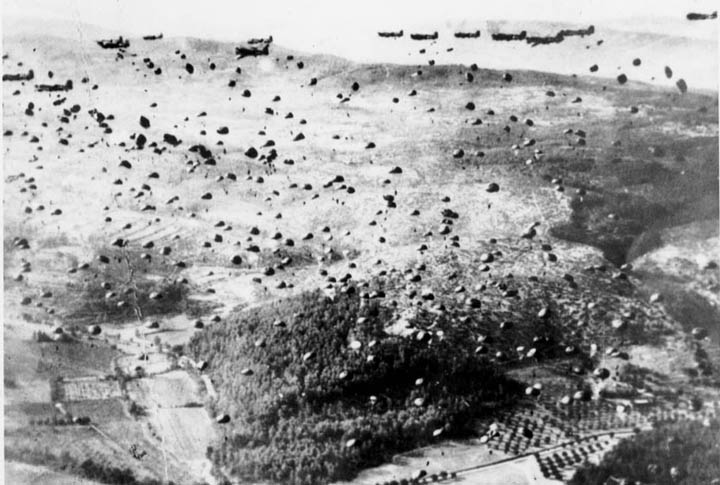
551st
jumps into southern France, 15 August 1944. (Signal Corps)
Lt. Col. (eventually Lt. Gen.) William
Yarborough, CO of the 509th PIB: “Your outfit came in at 1800. We got
in there about 0430, before dawn. I saw the whole thing and the best
drop of all was yours. It was beautifully done, there wasn't any doubt
about it. Your battalion's role in the South France operation was a
classic. Strategically it was for the purpose of taking the heat off the
right flank of the Seventh Army, along with the other units of the First
Airborne Task Force. In a larger sense, the operation was intended to
keep the German coastal forces from getting north and impeding the
movement of Allied forces across northern France. It was a beautiful use
of the airborne. Also, the nature of the terrain and the situation in
the South of France was such that regular, heavy infantry outfits would
have had a lot more difficulty in accomplishing those missions. The
airborne was more flexible. For instance, we chased the enemy up into
the Maritime Alps and then deployed along the passes in small groups and
engaged in mountain warfare. You couldn’t expect a regular infantry
outfit to do that to the degree that we did.”37
T/5 Dan Morgan: “It was our moment of
glory. We had rolled the dice with the German—a broad daylight jump
right in his backyard. We won. It was amazing. We took maybe five
serious injuries and two killed, and we had over 800 men, combat ready
and in position, waiting for the word to go. All our training was about
to pay off.”38
The battalion moved out toward its next
objective: the city of Drauguignan, population 10,000. The city,
headquarters for a German Army Corps, was garrisoned by a force of
about 750 soldiers.
Capt. Ed Hartman: “On D+1 we were
visited by a lovely French lady who bicycled in from the town of
Drauguignan, which was about six miles to our north. She reported that
the German troops who had garrisoned Drauguignan had evacuated the town
under FFI sniper fire after observing our parachute landing. She said
they had marshaled outside the town and were preparing to move back in,
and that severe measures would probably be taken against the population
in reprisal for the sniper fire. The Colonel was on a reconnaissance
mission then, so the battalion staff relayed the information to HQ,
First Airborne Task Force.”39
Major Ray Hermann: “The day after the
jump into South France the 551st was able to shift from the
defense to the offense. This is the way it happened. Ed Hartman,
Battalion S-2, got word that the German troops had pulled out of
Drauguignan and that French flags had been unfurled in the city. Now,
the S-2 was told, the Germans were returning to the city and the French
patriots would be placed in a precarious position. In the absence of the
Colonel, the Battalion Executive Officer radioed the information to Task
Force Hq. When the Colonel returned to our command post, the order from
Task Force was waiting for him: ‘Hold present position with minimum
force. Attack and seize Drauguignan.’”40
S/Sgt Charlie Fairlamb: "On D+2 we
took Drauguignan in one most grueling marches I've ever been on. Instead
of going up the road into the city, which was about mile, we went around
on the flank and up and down terraces. We got into the city at 0200 and
the men could hardly stand up. It was pitch dark and we hadn't made a
sound getting into town. Parties were organized to round up the Krauts
and that night we got about 500.
“About 0400 we laid down in the streets
to sleep, and imagine the surprise of the inhabitants when they saw
their town full of GIs in the morning. The people were wonderful to us.
They kissed us, hugged us and cried over us. We were a very
sorry-looking sight after only two hours rest. The women came and mended
our clothes and brought us water to wash in and did everything they
could for us. They had no idea we were coming until the afternoon
before, when we had quite a battle on the outskirts of the town.
“We set up our mortars in the town
square and fired all day and night. Snipers were very active on the
rooftops but no one paid very much attention to them. Most of the mortar
platoon was lined up along the curb as the tanks came into town. They
were sure they were the first and had quite a good reception, but when
they got to the square and saw all of us already there, their faces
dropped. We stood there and cheered them just like the civilians.”41
Cpl. Joe Cicchinelli: “The next day the
battalion moved in. While we were going to the town I went in a cave
behind the German headquarters and found four big burlap bags with
German and French currency—it was probably their payroll. There was
also some beer and cognac. I told some of the guys who were there with
me to take the beer for the officers and keep the cognac for the
enlisted men. Then we threw the sacks in a truck and took off down the
street. I was in the back and as we drove along, I threw all the money
out into the streets of Drauguignan, by the handfuls. People came from
all over and picked it up, and that was the end of the German payroll.
Boy, were we heroes!”42
The presence of the Americans emboldened
the French; everyone, it seemed, wanted to be a part of the act.
Sgt. Carl Noble: “Then we ran into this
little French kid about 13 who was carrying a big 10-gauge shotgun. The
guys kidded him, saying that if he ever fired it he would wind up over
in Italy, so he motioned for us to come with him and shows us an old
mattress. He turned the thing over and there was a dead German officer
with a big hole in him. That kid had done him in good.”43
A patrol of 14 men was led to a large château
by a prisoner who reported that it housed an important headquarters. The
squad, which was carrying two machine guns and a bazooka, surprised and
overwhelmed the German perimeter defense. After a brief but intense
firefight, during which several bazooka rounds were fired into the château,
the Germans surrendered. Those captured—Major General Ludwig Bieringer
and his entire LXII Wehrmacht Corps staff—were a rich haul for the
Allies and an embarrassment for the Germans.
Major Ray Hermann: “This involves the Saturday
Evening Post. Sometime in the period 1952-54 that magazine published
an article entitled ‘They'll Never forget Mark Clark.’
The article concerned itself primarily
with a tiff some members of that fighting Texas outfit, the 36th Infantry Division, had with General Clark over a river crossing
in Italy. But the author of the article went beyond that—he gave the
36th the credit for the liberation of Drauguignan. Of
course, a division is quite big and a battalion is quite small, so
perhaps when the 36th Infantry Division rolled through
Drauguignan it did not know that the 551st Parachute Infantry
Battalion was already there. Subsequently, the 517th
Parachute Regimental Combat Team was given credit for the liberation of
Drauguignan. That was based on the fact that the 460th
Parachute Field Artillery Battalion, a part of the 517th was ordered to provide artillery support to the 551st
in the attack; but the undeniable truth remains: the 517th
Regiment did not participate in the attack.”44
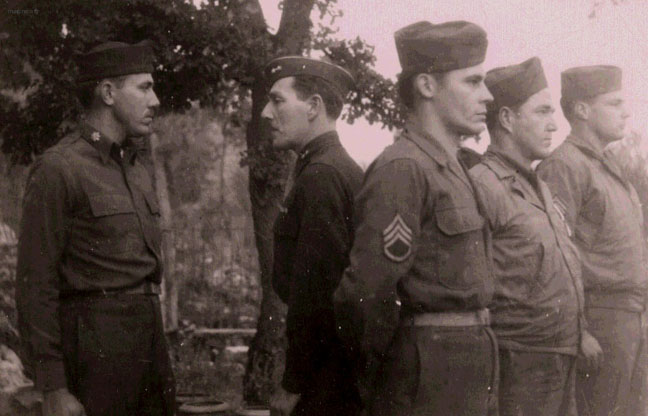
MG
R. T. Frederick (center) inspects a group of 551st men led by Major William
Holm.
The Battalion moved on toward
Cannes, and Hill 105.
Sgt. Emory Albritton:
“Company B was the lead company in a dusk attack, with the 1st
Special Service Force on our right. We went up on this hill, before
Cannes, in a frontal attack. There was a lot of firing in both
directions and then we came back off the hill and went up a draw on the
left side. It was a dry creek bed and by then it was dark.
“The artillery was as heavy
as you can possibly imagine. …they were traversing up and down the
draw and they were getting a lot of the guys. A dud landed right near me
and I stuck my handout and touched the nose and got burned good. Everett
Debarr was right in front of me, and all at once a shell exploded right
by us and he took all the shrapnel. He had big holes in his back, so I
figured he was a goner. They were using a lot of white phosphorus and it
was almost like daytime—there were a lot of small fires burning around
the area and I think Lt. Hecq got some phosphorus in the face. People
were moaning and groaning all around.
“Anyway, I had noticed a sort of ledge above us—a bunch
of rocks higher up. I asked Debarr if he was all right but all he could
do was groan. So I got hold of him (he was one of the bigger guys in the
company), and he was mumbling
'Help me, help me!'
Then the two of us sort of climbed up
and staggered up there, in all the artillery, and took cover the best we
could. The artillery finally let up and soon I heard hobnail boots
passing right below us as the Krauts came into the area.
“When it finally got light, I looked down on the darndest
mess you ever saw. The bodies of Company B's 2nd Platoon were strewn all
over the area down there. Across the draw was a German machine gun with
a three-man crew and a couple of ammunition bearers. I had given Debarr
a shot of morphine to keep him quiet so the Germans wouldn't hear
us—although he was tough as nails. After I had sized up the situation
I said to Debarr,
‘look, I can leave you here and try to
get up the mountain or I can take you and try to get back to our
lines.’ He
just mumbled so I started carrying him out. I just got him up on my
shoulder and started down the hill towards the Germans. I came very
close to them and they were watching us, but they did not stop us. As we
went past, one of them saluted me and I nodded my head.”45
Major Ray Hermann: “On Hill
105, Company B was just simply caught in heavy artillery fire and
suffered casualties. I think we may have had about 16 KIAs. That was a
single night engagement... for the next few days we maintained steady
pressure against the slowly withdrawing Germans, pushing them back
toward the Italian border. There was some rather sharp fighting in that
phase, but when we finally reached Cannes not a shot was fired as we
marched into that beautiful resort city.”46
From Cannes, the battalion
proceeded to Nice.
Lt. Dick Durkee: “The S-2 called me in and directed me to
take a patrol and find out if Nice was occupied by Germans. I was to go
to the edge of the city, report back by radio and then return. When I
got to the outskirts of Nice I didn't see any Germans and the city was
quiet and appeared deserted, so I said to myself, 'Damned
if I'm going to go back. We'll just go on in.'
So we just kept going, right down the
main street.
“Well, the first thing that happened was that a little
girl came out a one houses, and she was standing there with her finger
and her mouth—she was about five years old. She was just looking at
me, so I said 'Americans!'
Then she ran into the house crying 'Americaines!
Americaines!' Then people started shouting and screaming. They came
running out of all the houses by the hundreds. What had been a ghost
town as we started in soon changed into a circus. We were joined by some
FFIs and some local policeman, and then we found a Frenchman who could
speak English and asked him where was the best hotel in town, and then
we just moved in. That night the mayor came in—a band came and was
playing in the street. They played our national anthem and we all stood
out on the balcony and took the cheers of the crowd. Boy, they brought
us wine and champagne—flowers—you can't imagine. Well, finally I
called up our S-2 and reported in and the next day the battalion marched
in. Our battalion was the first to enter Nice, and my patrol was the
first American unit.”47
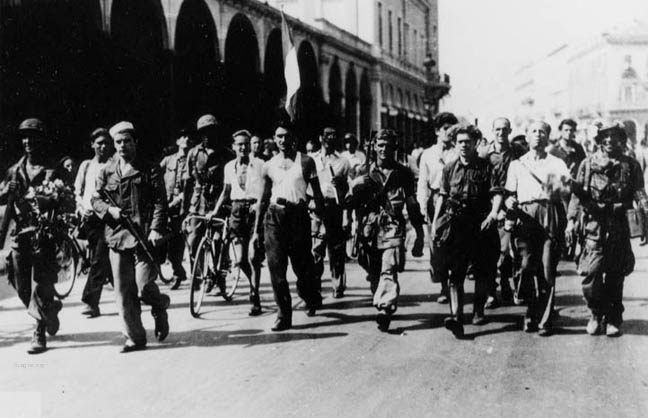
LT
Dick Durkee (far left) and his patrol enter Nice. (C. Fairlamb)
Lt. Durkee's patrol was
welcomed by the people of Nice on the morning of 29 August. The next
day, the city turned out to give the GIs a delirious welcomed on what
has become the official liberation day of Nice.
Maritime
Alps
Early in September, the
battalion moved into the Maritime Alps, where, along with the 509th
and 550th, it became part of the 509th Task Force,
the mission of which was to protect the right flank the 7th
Army.
As the 7th Army
rapidly advanced, the German forces retreated deeper into the mountains,
leaving behind the Austrian 5th High Mountain Assault
Division to keep the Task Force occupied. The 551st was
responsible for defending a frontline near a 40-mile portion of the
Italian border running from St. Etienne de Tinee in the North to St.
Martin Vesubie in the South.
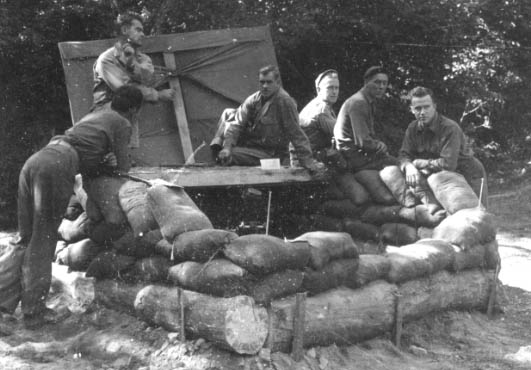
81-mm
mortar position near St. Martin Vesubie. (C. Fairlamb)
The Austrians, by virtue of
their position on the heights and their artillery superiority, held a
distinct advantage over the elements of 551st in the villages
below. But aggressive patrolling by the battalion prevented the
Austrians from mounting surprise attacks in strength.
T/5 Dan Morgan: “The
patrols they did send down our way came to frequent grief, and so a
stalemate of sorts ensued. The 5th held the peaks and ridges,
and we held the towns. Without a doubt, we had the best of it.”48
In early September, the
battalion’s rear elements, which had come across the beach in the
amphibious phase, caught up with the unit. Among them was Furlough.
Sgt. Carl Noble: “Furlough
got very combat-conscious while we were in the Maritime Alps. When she
moved, if we were expecting action, she would sense the tenseness in the
men and would go from cover to cover. She would turnaround and watch the
guys, trying to figure out what was going on.”49
Sgt. Don Garrigues: “On 5
October a howling blizzard swept over the entire area, blanketing
everything with deep snow. Our patrols used white ski suits for
camouflage, the same as the Germans. We also used skis and snowshoes
when it was to our advantage. It was by a strange quirk of fate that we
were fighting in knee-deep snow thousands of feet up in the Alps when we
had been trained for so long in jungle warfare. Sometimes our patrols
ambushed the enemy and sometimes we would be ambushed. Although we lost
some men, the enemy lost more. They were fighting in their native
surroundings but we were still beating them.”50
Sgt. Jim Stevens:
“Wintertime caught us then and we kinda suffered because we had our
jumpsuits and they were thin. Supply finally came up with some white
ponchos but they were just for the patrols, and you couldn't get shot in
those because they had to be brought back undamaged for the next
patrol.”51
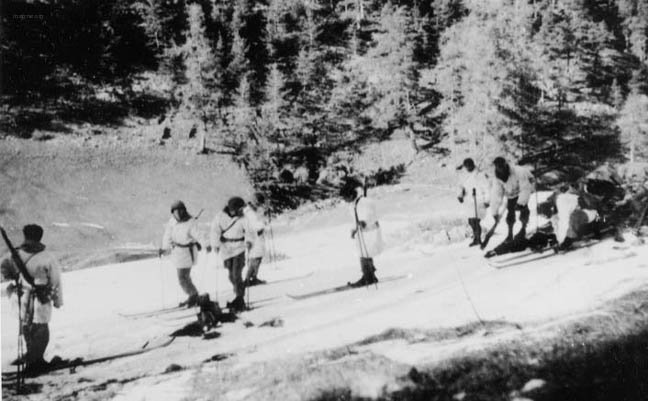
I
don't think we're in Panama anymore! 551st troopers on
patrol in Maritime Alps. (C. Fairlamb)
As was so often the case
during the war, it was the German artillery and mortars that took the
greatest toll, physically and mentally.
Sgt. Charlie Fairlamb: “The
shelling is beginning to tell on the men. German patrols have come down
into town and we have only about 15 riflemen and 14 mortarmen. We've
killed, wounded and captured our share of Germans while we've been here,
but I think if the shelling keeps up much longer, some of the guys will
go crazy. There is no place to go and nothing to do but wait for them to
shell some more.”52
On 18 November, after nearly
three months of sparring with the Austrians of the 5th
Division, the battalion was relieved and pulled back to St. Jeannet to
rest and re-equip before moving north across France.
The
Bulge
Sgt. Don Garrigues: “Shortly after the first of December,
we boarded 40 and 8 boxcars and departed from St. Jeannet on a French
train headed north. The Champagne
Campaign, as the invasion of South France was
sometimes called, was successfully completed and now we were ready for
our next mission. Our battalion had taken over 750 prisoners of war and
had inflicted an unknown number of casualties on the enemy. All of our
objectives had been accomplished in what historians have stated was the
most successful airborne operation of the war. For this, the 551st
paid the price of 163 casualties, of which 21 were either killed in
action or died of wounds.”53
(The number of casualties suffered by the 551st during
the war remains a source of controversy, but Garrigues’s figure for
the battalion’s dead in southern France is very close to the figure of
20 the author calculated after examining the battalion’s casualties
records in 2006-2007. See Roll of Honor.)
US
Airborne units were gathering in the area around Rhiems, where the XVIII
Airborne Corps was headquartered, in preparation of a final airborne
assault across the Rhine. On 8 December, the battalion arrived at its
new home, a military Academy on the outskirts of Laon, 30 miles
northwest of Rhiems. It was to be a short stay.
At
about 1930 hrs on 17 December, Lt. Col. Joerg was ordered to report
immediately to 82nd Airborne Division Headquarters. When he
returned, he assembled the officers and informed them that the battalion
was to be ready to move out by 1000 on the following day.
At 0400 on 18 December, the
battalion was notified that its destination was Bastogne. At 0900, one
hour before departure, the battalion was notified that it was reverting
back to XVIII Airborne Corps Headquarters under General Ridgway and
that it would remain in reserve at Laon. At 1600 hrs the battalion was
ordered to be ready to move out at 0200 on 19 December to the
headquarters of the 30th Infantry Division at Stavelot,
Belgium, for assignment. At 0100 on 19 December, the trucks to be used
to transport the battalion were recalled by Corps. Finally, the
battalion was loaded aboard 2½-ton quartermaster trucks and set out for
the Ardennes. The confusion that would characterize so much of the
Battle of the Bulge was already in evidence.
T/5 Dan Morgan: “The trip
lasted about two full days for most of the men and at least once and
possibly three times the convoy was fragmented and its parts went off in
different directions. Although a large part of Eastern Belgium was
technically behind the German lines because of von Rundstedt's
breakthrough, the roads through the German held area were frequently
open, and if you are smart enough and lucky enough to avoid the
occasional roadblock, you might travel quite a way—even get where you
were going.”54
Capt. Ed Hartman: “We were
to link with the 101st Airborne Division and our initial
destination was Bastogne, but somewhere during that wild night ride it
became obvious that Bastogne had already been surrounded. We were
rerouted to the town of Werbomont to link up there with elements of the
82nd. I'm not sure that the 82nd was even there
then. The 'Old Hickory' Division (the 30th) was holding the
line in that area and conditions were in a state of upheaval at that
moment. We did arrive at Werbomont and from there we moved to towns like
Spa and Malmedy. Total confusion reigned at that time. Eventually we
were 'engulfed' by elements of the 82nd, and from that point
on, are fate must be considered as part of the 82nd
Division”55
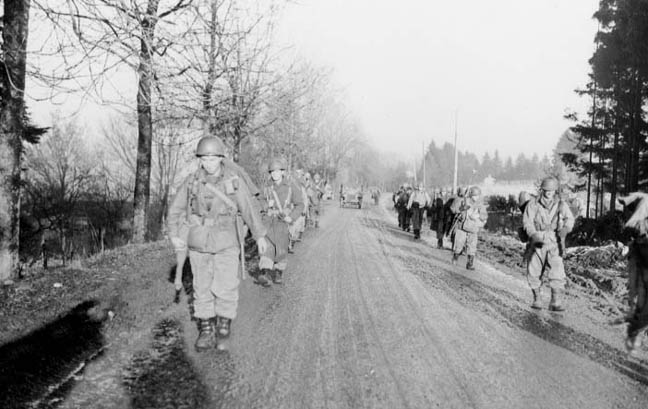
Men
of the 551st moving up early in the Bulge, before the weather
turned. (Signal Corps)
A truck loaded with mortar
rounds was placed at the end of the convoy to minimize damage to the
other vehicles should the load detonate. Its driver was Pfc. Milo
Huempfner. Just outside Leignon, Huempfner lost control on the icy road
and the truck plunged upright into a deep ditch. The cargo was
off-loaded to another truck with the help of civilians from Leignon, and
Huempfner was ordered to remain with his truck until a wrecker could get
to him. It would be two weeks before Huempfner rejoined the battalion.
Provided with food by local
civilians, Huempfner stayed with his vehicle for several days, until a
German tank column approached, heading for Leignon. Huempfner destroyed
his truck and entered the town where, for the next two days, he
conducted a one-man war against the Germans, venturing out at night to
shoot German soldiers or to destroy their armored vehicles, and warning
approaching Allied columns of the German armor present. When elements of
the 2nd Armored Division entered Leignon, they found
Huempfner with 18 German prisoners. For his actions in Leignon,
Huempfner was awarded, at the recommendation of the 2nd
Armored Division, the DSC.
Fragmented during the trip to
the front (a front that seemed to be everywhere), the battalion
regrouped during the period 22-25 December in a series of bivouacs
around Ster, Stavelot, and Werbomont. The scene in the area was one of
complete devastation. Nighttime temperatures near zero (°F) and nearly
a half-foot of snow on the ground drove the men to seek shelter in
abandoned buildings and with civilian families.
The confusion generated by
the rapid German advance created a near vacuum where hard information
was concerned. The vacuum was soon filled with rumors, and this in turn
fed the confusion.
T/5 Dan Morgan: “Major
General Jim Gavin, commanding the 82nd Airborne Division,
visited our bivouac at Rahier on 27 December. He gave the battalion a
pep talk after the style of General Eisenhower on the eve of the
Normandy invasion. Gavin announced that the 551st had been
selected to make the initial ‘raid in force’ against the Germans in
the Bulge. We were going to turn it around and start things going the
other way. He stressed that we were receiving a signal honor and that we
might take very heavy casualties but our mission was vital, and a great
deal depended on the outcome. In short, we would pass through the US
forward lines, penetrate about four miles into German-held territory,
attack and reduce the German-held village of Noirefontaine, and then
return to base with prisoners for interrogation.”56
Capt. Ed Hartman: “On 27
December General Gavin came to the command post of the 551st,
walking across the snow-covered fields unaccompanied, his rifle over his
shoulder. There, in late evening, he proposed that the battalion make an
attack in order to determine whether conditions were right for an Allied
counter-offensive. So he had, in effect, selected us to be his
‘pigeon’ for the testing of German mettle.”57
Major Ray Hermann: “We were
to pass through the lines of the 508th Regiment and stage a
night raid in battalion strength. We weren’t too confident. Taking six
or seven hundred men into enemy lines is one thing, but getting them
back after the fight has started and your presence is known is something
else. Just before we jumped off, General Gavin called on us. He squatted
down in the snow with us and talked over our plans. Things like that
make a general a General. The realization that a two-star general was
interested in our raid made us all feel better; we were eager to go.
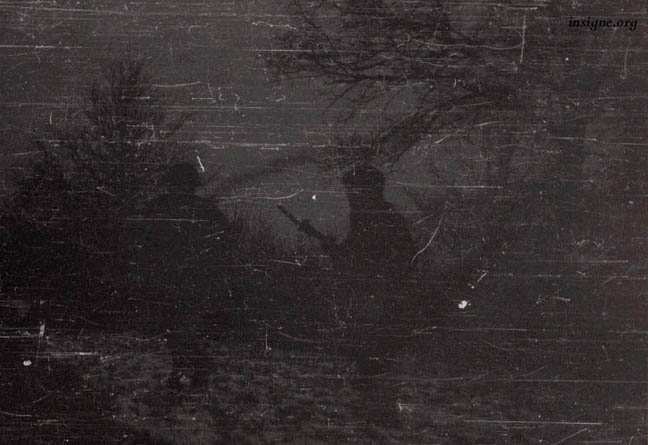
Snapshot
taken during night assault on Noirefontaine. (C. Fairlamb)
“It turned out amazingly
well. We penetrated about 5,000 yards into the German lines, burned some
buildings which they were using for barracks, and caught a lot of them
with our surprise rifle, machine gun, and mortar fire. We had a few
casualties, of course, but we made an orderly withdrawal as planned,
carrying our wounded out with us, and from then on we definitely belong
to the 82nd Airborne family.”58
After the attack, the
battalion pulled back, through the lines of the 508th, to
Rahier, where it remained for the next six days. German artillery
activity continued at a high level; it was not a peaceful six days.
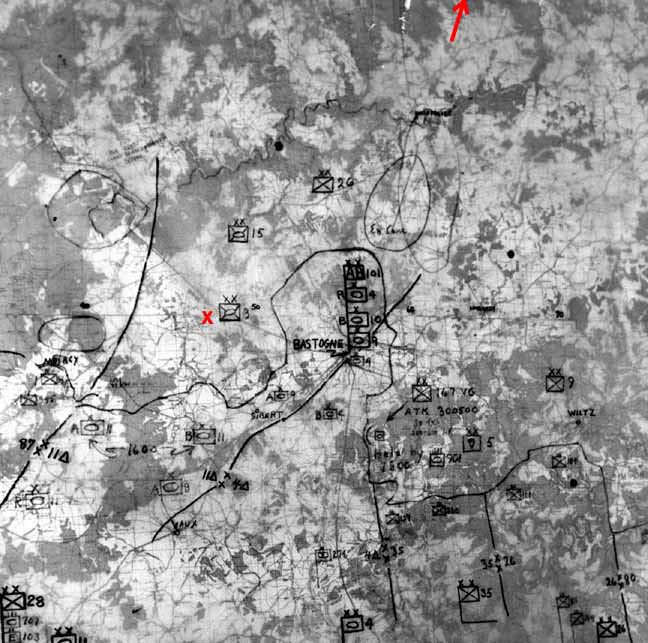
VIII
Corps Headquarter's war room situation map on 2 January 1945 showing the Bastogne
pocket
in the shape of
a
man's head, his nose pointing at Koblenz. The 551st was located about 25
miles
north
northeast of Bastogne,
in the direction
of the red arrow; the 550th IAB, sister battalion of the
551st,
was six miles
west of Bastogne,
at the red X. This section of map is about 30 miles on a side.
At 0430 hrs on the morning of 3 January,
the battalion moved to the road that ran from Trois-Ponts to Basse
Bodeux. The road would serve as the Line of Departure (LD) for an attack
by the battalion on elements of the 2nd and 9th
Panzer Divisions, the 164th SS Regiment, and the 62nd
Volksgrenadier Division. Companies A and C would participate in the
attack with Company B in reserve.
As the battalion made its way along an icy road to the forward
assembly area, a gap opened between the command group and the leading
rifle company. The gap was of little concern to LTC Joerg, because he
planned to pause at the turnoff to the assembly area. Besides, on the
previous day, the Assistant S-3 had briefed one NCO from each company on
the assembly area and the route to it, and afterwards each company
commander was to have performed his own reconnaissance of both. But the
Asst. S-3 had reconnoitered the wrong area, as had the NCOs who followed
his directions, and the first rifle company took the wrong turnoff. An
officer was dispatched to return the column to the proper track. But the
battalion was late to the final assembly area and 45 minutes late
crossing the LD.59
In an effort to allow the men
to advance as rapidly as possible while carrying equipment and
ammunition, they were ordered to leave their heavy overcoats and
overshoes behind, to be brought up later that day.
Capt. Tims Quinn: “Upon the
recommendation of all company commanders, heavy overcoats and overshoes
were to be left in the company piles during the initial phases of the
attack and then brought up on the afternoon of 3 January. This decision
was made due to the equipment and ammunition we would be caring. We
considered that the attack could be pushed forward more rapidly with
such bulky and cumbersome items disposed of.”60
Major Ray Hermann: “Doughboys couldn't fight, we
decided, loaded down with blanket rolls and overcoats, so we stripped
for action. We would have
the blankets and overcoats sent forward later when trucks were able to
get through... At the end
of the first day the trucks couldn’t get through because there were
mines on the road.”61
It would be days before the
men would see their cold-weather gear again; some would freeze to death
before they did. (Gregory Orfalea believes that the high number of
weather-related casualties suffered by the 551st in the
Ardennes was the result of General Gavin’s orders.62
The statements of 551st veterans, such as those quoted
above, contradict this. The broader truth is that there was a general
failure on the part of unit commanders to appreciate the debilitating
power of the bitter weather in which their men were fighting.)
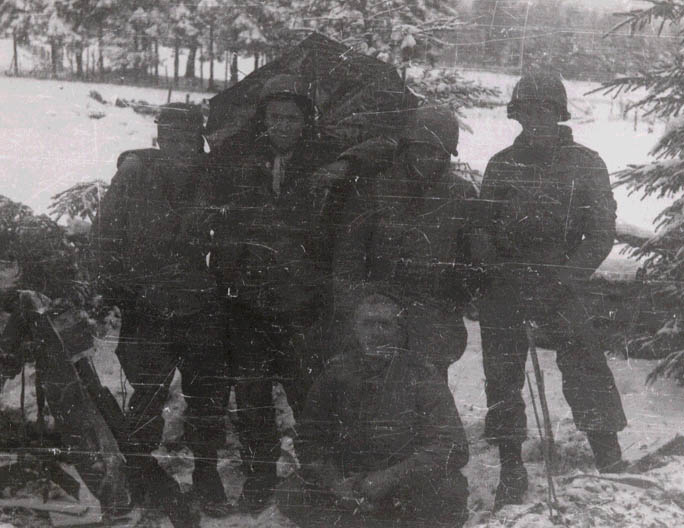
Members
of the battalion's Mortar Platoon, Battle of the Bulge. (C.
Fairlamb)
Capt. Tims Quinn: “We had to pass across the highway and
over an open field approximately 5,000 yards wide and 700 yards deep to
get to the edge of the wood held by the enemy. I then began to look for
Company I [of the 508th, on the flank] on my right but could
find no sign of them. Because of the delay, we were now about 30 minutes
late in crossing—we were waiting for Company A to get in position and
for the artillery concentration. Then I heard fighting on our right
front, and I found out later that the 3rd Battalion of the
505th, on our right, had pushed a platoon up across the field
before daylight and it had become engaged and this later involved the
entire company. This meant there was no coordinated attack but instead
individual elements were fighting separate engagements. About this time,
four rounds of fire from Division Artillery came in and struck the edge
of the wood to our front. I turned to the FO and exclaimed, ‘that's perfect! Now,
give us the concentration.’
He answered, ‘that is
the concentration.’ Due
to the shortage of ammunition, he said, they could only fire at definite
targets. By now we were receiving mortar fire and also long-range
small-arms fire.”63
Sgt.
Bill Hatcher: “When we went into the attack on the 3rd, I
couldn't believe my ears—there was actual shouting—the battle yell.
I thought that went out with the Civil War—the Rebel yell. But here
was the 551st, this spirited outfit, going into the attack
yelling. I remember all the cooks and bookkeepers and others coming up
to the front, being called up as replacements, but mostly I remember
that particular scene of the attack and in the yelling, like something
out of the 19th century or like the Marines with John
Wayne.”64
S/Sgt. Jim Stevens: “We had
to cover this open ground—the Germans let us get all the way in, just
about up to their positions—and naturally, we didn't have any white
suits or anything for camouflage in that snow so we stood out real
good—and then they just opened up on us with machine guns and
everything. They chewed up Company A quite a bit.”65
Lt. Dick Durkee:
“...Company A strength was 142 enlisted men and eight officers. Few
realized that only six men and one officer would reach the last phase
line. ... Attacking toward PL2, our company was working itself up a draw
when we came to an open field. Two hundred yards beyond was a patch of
woods, and by the looks and sounds of it we could tell Jerry was digging
in. Our company commander asked for artillery support on the objective
and receive some, but as usual, it didn't hit where you wanted it, even
though we had a forward observer with us. The attack order was then
given and the platoons advanced over the open ground with 1st
and 3rd on line and mine in support. A hundred yards from our
objective the Krauts opened up with all their automatic weapons and we
hit the ground and started to crawl. As if that wasn't bad enough, a
German 88 opened up on us from our left flank and started searching up
and down our positions. The wounded were screaming and the medics were
heroes as usual and were crawling back-and-forth administering first aid
to the wounded.
“Thinking it best to get
out of the area the 88 was hitting, I jumped up, called to the men to
follow me and led them around the right flank to a patch of woods. Then
I set up my machine guns and fired on the left flank of the Jerry. They
withdrew...
“Germans were still around
the area when darkness fell, and we went out to get the wounded. The
snow was falling and did a good job of hiding the bodies of the men. It
was hard to tell the wounded from the dead. We finally managed to get
all our wounded out onto the road and started back to Fosse where they
would get medical attention...
“At we staggered down the
road, I happened to look back at the battlefield, and the sight will
never leave me. The bodies of our comrades were strewn about where they
had fallen and were practically covered with snow. I could see one-man
leaning against a fence post—he apparently was going to climb over it
but just didn't quite make it...
“By 2400 all companies were
going into the battalion assembly area, and it was there that Lt. Booth
regrouped Company A, which was by then up to a strength of 79 men and
five officers. In the first day of the push we had lost our company
commander, two platoon leaders and 68 men...
“The night was about over.
At 0300 the men tried to get some sleep but it was impossible. The
temperature was 10° Fahrenheit and the snow was about a foot deep. They
tried to get some rest by scraping the snow away and line on the bare
ground, covered with their gas capes (a thin piece of cellophane). The
noncoms were told to go around and wake up anybody who fell asleep
because it was very easy to fall asleep and never wake up.”66
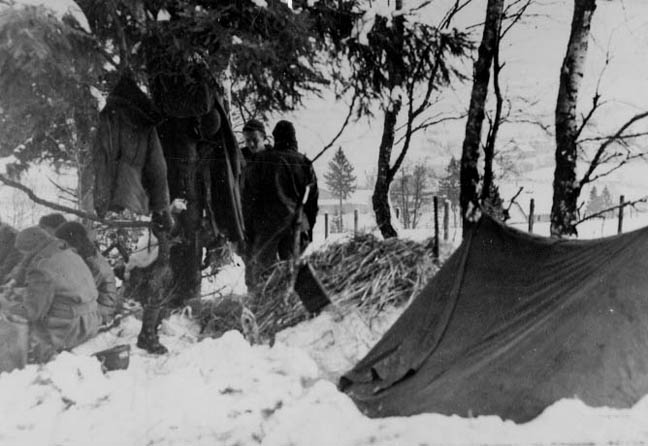
Command
Post
of Company C during the Battle of the Bulge. (C. Fairlamb)
Sgt. Bill Dean: “I was
assigned to Company A and we had 18 men. Lt. Lawler was in charge and I
was Section Sergeant. We had four machine guns in that section when we
made contact with the enemy on the morning of 3 January. They pinned us
down with machine guns set in a fence row. It was very cold, lots of
snow—probably knee deep. I saw the Col. there among us when we engaged
the enemy in heavy battle. He had several men with him and he was there,
right in the midst of the battle.
“He was speaking to us and
encouraging us. He was very kind and manifesting real leadership as he
always did. That morning was the last time I saw him alive. He was
standing out there directing that attack. He wasn't lying down, trying
to hide or take cover. It was an inspiration for his men to watch
him.”67
T/5 Dan Morgan: “The evening of 3 January found Company A
in a state of shock, attempting to sort itself out and regroup for the
renewed attack that was scheduled for the morning. The Colonel had done
his best to have the Battalion taken out of the battle and placed in
reserve, but he had been refused and ordered to continue the attack. We
were then attached to the 517th Regiment.”68
(According to Orfalea, Joerg’s request that the battalion be relieved
was not made until the evening of 6 January.69)
At 0630 on 4 January, the
battalion left the next Phase Line. Although this was only the second
day, lack of sleep, physical exhaustion, and poor clothing coupled with
near-zero temperatures were beginning to take their toll, and there was
no end in sight.
Lt. Dick Durkee: “Company
A, because it had taken a great many casualties, had been placed in the
rear of the battalion. At about 1600, the leading company ran into some
very heavy sniper fire and the Colonel ordered Lt. Booth to send one
platoon up on the right flank of the battalion to see if they could
knock out the enemy. My platoon was selected and divided into two
patrols, one led by Lt. Jerry Quinn and the other by me. We had
progressed about 200 yards into the woods where the snipers were when
all hell broke loose. The Krauts were dug in about 50 yards to our right
front and were laying down all their fire on my patrol. They apparently
were not aware of Jerry Quinn's patrol coming up on the left, so it was
a perfect set up—Jerry practically had his back turned. Meanwhile, it
was no darned picnic for us. We were helpless and several of our men
were severely wounded. Too late, the Krauts saw Lt. Quinn, and their
fire was lifted as they tried to turn their machine guns around. We
attacked and they were caught in a hopeless situation. They never had a
chance. The men, having seen so many of their buddies killed and wounded
during the last 24 hours, were not in a forgiving mood, and every Kraut
was killed to a count of 64. They all died in their foxholes—some
probably tried to surrender but couldn't seem to convince us of their
intention—so the German army with short 64 supermen.”70
Lt. Dick Goins: “We moved
into a defensive position that night and awaited orders from Division.
By this time the cold weather was taking its toll. Trenchfoot and frozen
feet or hurting the battalion as much as the enemy. That night we got
orders to attack the town of Dairomont, clear it, and then advance to a position just west of the town of Rochelinval. There we were to dig in
and wait for further orders.”71
On 5 and 6 January, the
battalion was resupplied and moved into position for the final assault
of Rochelinval.
T/5 Dan Morgan: “The stage
was finally set for the battle of Rochelinval. The German garrison, some
700 strong, settled down for the night in their warm quarters in the
town. The approximately 250 men who were what was left of the 551st,
their feet frozen and their stomachs empty, slept in the snow.”72
Once again the 551st
was to attack across open ground with minimal artillery support against
an enemy that was dug in and waiting.
Lt. Dick Durkee: “We
arrived at our Line of Departure and sent up a yellow flare so the other
companies would know we were there. Booth then had our attached Forward
Observer call for the concentration to be laid down on the objective.
There was plenty of static on our SCR-300 radio, and contact was very
poor. We finally got two salvos after one artillery unit argued with our
Forward Observer, claiming that the target was out of their area. After
considerable discussion and the intervention of the Colonel, they
finally consented. The artillery didn't do much good: it only warned the
Germans that they were about to be attacked.
“By that time it had
started to get light. All the time we were waiting we could hear the
Germans preparing their defenses. Sgt. (Robert) Hill told me it was
going to be a bloody fight and a hell of a lot of our men would never
get there. He hardly realized that not one of us would get there. Our
route of attack was a little country lane with scattered brush on each
side. We were about 250 yards from the town and there was a fence to our
right.
“The Germans were setting
up there in the town, just waiting for us. But orders were orders, so
when Booth gave the nod we went. I had one squad, led by Sgt. Hill, to
go down the lane on the left side by the fence, and the other squad, led
by Sgt. Courtney, to go down the right. Lt. Dahl and I were in the lane
behind the two scouts, leading. One scout, Pvt. Robert Mowery, was
carrying the BAR and he was the first to be hit; he got it in the
stomach and once in the head. I immediately had our machine guns
emplaced behind the stump, but they no sooner got set up than the
Jerries opened up on our left flank and then those men were directly in
the crossfire. Before they got off their second burst, they were both
dead.
“I was then on the very
outskirts of the town. I had one bazookaman left, the other having been
killed right after Dahl. Then I saw one man about 50 yards back down to
draw and recognized him as my runner, Pvt. Pat Casanova, and I yelled at
him to get the riflemen up to me so we could continue the attack, and
his answer is something I will never forget. He shouted back, 'Sir,
they're all dead.'
“Well,
I figured we had had it. I told the bazookaman to crawl back down the
draw and I would cover him. I figured there wasn't any sense in
attacking the town with two men. He got about three feet when a machine
gun opened up on him and put about a quarter of a box of ammunition into
him. I crawled around the bend in the lane, moving back, and I saw the
reason for Casanova's answer: there at our machine guns were the men who
had been having such a great time the night before eating steak
sandwiches. They were lying this way and that, some face up staring at
the sky with sightless eyes, and others face down in the snow. Looking
on down the lane I could see men sprawled every two or three yards. They
were not wounded because they were in plain view of the Krauts, who had
been using them for target practice or something because they had been
hit many times. How I ever got out of that alive, God only knows...
“I found out I was now company commander of a company of
nine men...”73
The
man Dick Durkee remembers as Sgt. Hill was Cpl. Robert H. Hill. Assuming
leadership of his squad when the squad leader was killed, Hill stood and
fired on the German machine gun positions with his BAR to cover the
withdrawal of what was left of the squad. Though severely wounded, he
changed clips and maintained fire, knocking out one of the German
machine guns. Wounded again, he fell to his knees but continued firing
until a German Sniper’s bullet ended his life. For his bravery, Cpl.
Hill was recommended for the Silver Star. But General Ridgway interceded
and personally signed the endorsement upgrading the award to a DSC.
Hill’s having won the DSC was unknown to the battalion’s
survivors until 2006, when 551st veteran Col. Douglas Dillard
located the documentation at the National Archives.74
“Pvt. Roger Carqueville:
“That morning they had us pinned down with small arms fire and they
were throwing artillery on us. There was a big firefight, but the whole
time I never saw a target to shoot at. I was only 10 feet from the
Colonel when a shell came in, a tree burst. It blew above us and a piece
went through the Colonel's helmet. That was about 0800. There was
nothing we could do for him.”75
Lt. Col. Joerg was carried to
an aid station where he died a few hours later. Major Bill Holm assumed
command of the battalion.
T/4 Harry Renick: “...
After we [Company A] pulled back, the other company went in and took the
town with the help of a light tank. There were 250 prisoners and we had
only 60 men in our whole company at the start of the attack. After it
was over, there were only four or five of us left.”76
Rochelinval fell on 7 January
1945. The battalion held the town for two days before being relieved.
Furlough
T/5
Dan Morgan: “Furlough was probably left behind at Laon when the
Battalion convoyed to the front, but no one seems to know for sure...
Only two of our men claim to have seen her during the period 3-7
January, up front in the Bulge. Knowing the resourceful nature of our
men, I'm inclined to believe she may have made it. I know the GOYAs
would have wanted it that way.”77
Disbandment
On 10 January, the battalion
was withdrawn to the Stavelot/Juslenville area and quartered with
civilian families. Near the end of January, the battalion was assembled
and the men informed that the U.S. Army had done what the German army
could not do: destroy the 551st.
T/5 Jack Affleck: “On the
27th General Gavin came down and there were about a hundred
surviving officers and men of the battalion gathered. Major Holm was in
command. Gavin gave a little speech: he was sorry the Battalion was
being broken up; he understood we had been together; he regretted our
high casualties. Then we went down to Personnel and were assigned to the
different regiments of the 82nd Airborne.”78
[The number of casualties the battalion suffered during the Battle of
the Bulge, as well as the number of survivors, is a source of
controversy. For a discussion of both, see Roll of Honor.]
The
551st was officially disbanded on 10 February 1945. Three
weeks later, two other independent battalions—the 509th PIB
and 550th IAB—were disbanded. Most of the men remaining in
the two paratrooper battalions were dispersed among the regiments of the
82nd Airborne Division (men with high points were assigned to
the 17th Airborne Division, which was
slated for return to the States). The 550th was kept intact
and became the 3rd Battalion of the 194th Glider
Infantry Regiment of the 17th Airborne Division.
Although
its official lineage indicates that the 551st was
reconstituted in 1947, this was a reconstitution only on paper. When the
551st PIB was disbanded in 1945, it ceased to exist as
operational unit.
Why
was the 551st disbanded?
Each
of the three independent battalions disbanded during or immediately
following the Battle of the Bulge, by virtue of its size and
independence, was especially close-knit, and there was widespread
dismay—and in many instances anger—among the men when they learned
of their battalion's demise. It did not help that the reasons for
disbandment were never explained. While veterans of the 551st
have posited a number of reasons for the break-up of the battalion, few,
even today, understand what actually happened. They are not alone. LTG
William P. Yarborough, the first commanding officer of the 509th (though
not its CO at the time of its disbandment) is quoted as saying he had
been told by the War Department that General Mathew Ridgway had ordered
the disbandment of the 509th.79
Yarborough’s source was wrong: not even Eisenhower had the power to
inactivate these battalions. Only the War Department wielded such power.
The
single official document I have seen that relates to the disbandment of
the 551st
is one dated 15 January 1945 from the Office of the Adjutant General,
War Department, to the Commanding General, US Forces in the ETO. Within
Paragraph 2 of the document it states that the 1st
Battalion, 551st Parachute Infantry is to be inactivated, and
that concurrent to the Battalion's inactivation, the 551st
Parachute Infantry is to be disbanded. At the top of the document is the
notation "Immediate Action." Given the date of this order, it
is tempting to conclude that the casualties suffered by the battalion
during the Bulge were the reason for its disbandment. Other evidence,
however, argues against this view.
In
the case of the 509th, the order authorizing its
disbandment, issued by the Adjutant General's Office of the War
Department, reads, in part: “TO: Commanding General, USF in the
European Theater of Operations. 1. The 509th
parachute infantry Battalion will be disbanded at the earliest
practicable date. 2. a. Personnel rendered surplus by this action will
be absorbed within the replacement system and reflected in future
requisitions... by order of the Secretary of War.”80 The order is dated 1 December 1944,
two weeks before the Germans' Ardennes offensive.
There
was no reason to single out the 509th
(the most battle-experienced of the three battalions) for disbandment.
Almost certainly, a similar, if not identical, order was issued for the
550th
and 551st. This is supported by a statement of
William Holm, Commanding Officer of the 551st
at the time of its disbandment: “General Ridgway also said he had had
orders to break up the separate parachute and glider battalions earlier,
from the War Department, but he had held up the action when the Ardennes
offensive started.”81
(A former historian for the Army’s Center of Military History
attributed the inactivation of the battalions to a systematic adjustment
to the troop basis to correct a shortage of combat replacements and an
excess of small specialty units.)
Based
on the evidence, I am drawn to the conclusion that casualties, while
undoubtedly an important factor in determining when the
independent battalions were disbanded, was not the reason why
they were disbanded. Indeed, had it not been
for the Battle of the Bulge, these battalions probably would have been
disbanded earlier than they actually were.
Was
the 551st nearly wiped out?
No, the battalion was not nearly wiped
out, though readers of Gregory Orfalea’s history of the unit may
believe that it was. Mr. Orfalea wrote: “Of 643 officers and men who
went into the counteroffensive on January 3, 110 (96 men in 14 officers)
were left at the end of January 8.
All the rest were killed, wounded, or missing [emphasis
mine]; at least 60 were killed in action or died of wounds from the
Ardennes's counteroffensive, bringing the number of 551st dead to just
over a hundred.”82 This statement,
in one form or another, appears to have served as the literary
equivalent of a soundbite for many who reviewed Mr. Orfalea’s book and
for many of the press who covered the award of a Presidential Unit
Citation to the battalion in 2001. Apparently, these individuals did not
know—and some, I suspect, would not have cared had they known—that
the statement is as inaccurate as it is dramatic.
Mr. Orfalea’s statement is inaccurate
for three reasons. First, in the Ardennes
the battalion
suffered a significant number of nonbattle casualties (most of them
weather-related)—casualties that were not counted as
killed, wounded, or missing. How many nonbattle casualties did the
battalion suffer? A cumulative casualty report of the XVIII Airborne
Corps dated 9 February 1945 placed the number at 273—40% of the
battalion’s initial strength. Second, the battalion’s own casualty
reports list 46 dead for the Ardennes campaign.
Third, a careful examination of all the battalion’s combat
casualties accounts for 66 dead. [See Roll of Honor.]
It is instructive to compare
the state of the 551st at the time it was withdrawn from
combat to that of the 509th when it was withdrawn from
combat. LT Morton Katz of the 509th noted, “After this last
action, seven officers and 48 men came down the hill on 28 January 1945.
All the others were either dead or hospitalized.”83
There are two points to be made here. First, the distinction between wounded
and hospitalized is an important one, as the latter includes
nonbattle casualties and the former does not. Second, despite having
been reduced in strength during the Battle of the Bulge to at least the
same degree as had the 551st, and like the 551st
having been disbanded shortly after having been withdrawn from combat,
today there is not a popular belief that the 509th was nearly
wiped out in the Battle of the Bulge.
At
the same time, it should be pointed out that the Battle of the Bulge casualties of the 509th
were incurred in 24 days of combat; those of the 551st in
only eight days of combat (and most of them during a period of five
days). The case can be made, especially in light of the number of men
killed (46 in the 551st; 25 in the 509th), that
the combat in which the 551st was involved during the Battle
of the Bulge was remarkably bloody.
Was
the 551st the victim of a conspiracy?
Dan
Morgan: “The pertinent battalion records appear to have been
destroyed or lost in some manner. Searches
of the National Records Center holdings at Suitland, Maryland, have been
very disappointing—although the staff were most helpful. A careful
review of their holdings for XVIII Airborne Corps, the 82nd Airborne
Division, the 504th, 505th, 508th
Parachute Regiments and the 517th Parachute Regimental Combat
Team resulted in only an occasional reference to the 551st at
times when the Battalion was on the ‘point’ of the Trois-Ponts
Sector attack and should have figured significantly in radio traffic and
other communications. All
such references have been included in this book.
They have become significant by their very scarcity.
There is no mention anywhere of the Battalion's attack on
Rochelinval, nor of the near-annihilation of the Battalion.
“I
note in passing that where the regiments are concerned, each objective
taken, each successful attack or repulse is documented in the classified
radio traffic of those days in such a way that some small glory or
recognition would settle where it belonged.
People at Division and Corps read that traffic carefully each day
and forwarded their opinions of the battle situation and participating
troops accordingly. Looking
back from this very distant time I feel compelled to say that it seems
likely to me that there were persons in the staff sections of
regimental, division-level or both, who systematically struck out or
downgraded the activities of the 551st Battalion.
If such was in fact the case, then their purposes in doing so
could range all the way from incompetence to callousness to deliberate
malice, and I doubt the truth will ever be known.
The purpose of this story is not to seek them out for censure but
to secure for the 551st the recognition in earned."84
Given
the high-risk assaults the 551st was ordered to make in the Ardennes, its
subsequent disbandment, and the obscurity to which history has relegated
the battalion, it is understandable that the veterans of the 551st
would feel that they and their unit were badly treated and unfairly
deprived of the recognition due them. But unfairly
deprived by whom? And was it happenstance or intentional? If, as Mr.
Morgan suggests, the battalion's activities were systematically
struck out or downgraded, then it is doubtful it would have been from
incompetence or callousness, but instead from deliberate malice. This
appears to be the view of Gregory Orfalea in his book on the battalion. But while Mr. Morgan chose not to search for those responsible,
Mr. Orfalea did. And much
of his venom is directed at Rupert D. Graves.
Graves
had commanded the 551st for a period of about five months
while the unit was at Camp Mackall. It had been an unhappy five months
for both Graves and the enlisted men of the battalion. During the
battalion's stay at Camp Mackall, morale had deteriorated among the
enlisted men, who, already well-trained and expecting to be sent to a
combat theater, found themselves Stateside in what seemed to be an
endless cycle of training. The rate of AWOL among the men skyrocketed. Graves was not the cause of
these problems, they began before he assumed command of the battalion,
but they were his to deal with.
Graves's stern leadership
style in dealing with a unit that he believed to be out of control might
have been more effective in a new unit, but directed at the men of the 551st,
who had been together for a year, it seemed only to exacerbate the
situation. The situation was resolved when LTC Graves left to assume command the 517th
PIR and LTC Joerg returned to take
command. Joerg quickly secured the release from the stockade of any
member of the 551st who gave his word
not to be a repeat offender. Apparently, Mr. Orfalea felt that when Graves left the 551st,
he took with him a lingering animus toward the battalion.
And when the paths of Graves and the 551st again
crossed, that animus came into play.
While
portraying Graves, and others, as a villain in the story of the 551st
may appeal to the conspiracy theory crowd, I found it
unconvincing. It is entirely reasonable
that Graves's stint as CO of the 551st
left him viewing the battalion as undisciplined, and that he might have
had qualms about its effectiveness in combat. But would such views have
led him to acts of vindictiveness directed at the 551st?
There is no evidence that Graves was that sort of person and substantial
evidence that he was not. Graves was respected as a leader and as a man
of honesty and integrity by the officers of the 517th PIR.85
And the the opinion of Graves among the officers of the 551st
differed considerably from that of the battalion's
enlisted men. Dan
Morgan: “... the officers' view of Colonel Graves suggests a very
mature, well-intentioned, likable, professional and tough-minded career
officer.”86
William Holm (last CO of the 551st): "I have always thought a lot
of Colonel Graves. He was a soldier."87
What,
then, did account for the “near annihilation” of the 551st
and its subsequent obscurity?
In
my opinion, the 551st was largely a victim of its status as
an independent battalion. Mr. Orfalea refers to the 551st as
a “bastard unit.”88 I
understand his choice of the word "bastard"—to create, I
think, a sympathetic image of a unit that was unfairly something of an outcast, perhaps even
an embarrassment to the Army brass—but I believe the more accurate
term is “orphan unit.”
Being
an independent battalion fostered a tremendous unit identity
among the men, but there was a downside to its small size and independence: No champion on higher councils
and little recognition of its activities. Had the battalion been part of
a regiment, the regiment would have had a vested interest in recording
the battalion's activities. And had the regiment, in turn, been part of
a division, then the division would have had a similar, vested interest
in recognizing the battalion and its achievements. The 551st
had no one at a level above the battalion looking out for its interests.
The problem was compounded by the chaos and confusion of the
Battle of the Bulge, and the 551st was largely overlooked in
the official records of other units. It was not by design or from
malice; it was in the nature of being an attached unit—an orphan,
passed from foster home to foster home. And in terms of receiving
recognition, the Ardennes in the winter of 1944-45 was
not a good place to be an orphan unit.
The
situation is well described in a three-page history of the unit that was
among a 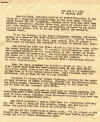 number of items given to me by a veteran of the 551st.
The history, which appears to have been written by a journalist, is dated 15
January 1945 and carries an address of APO 469 US Army. The first page
is shown here in a thumbnailed image. The first paragraph reads:
“Headquarters, European Theater of Operations – This is the story of
a separate battalion – one of several small units which travel the ETO
incognite, serving first with one unit then another, frequently missing
their full share of credit for a job well done because they are not
permanently assigned to an organization and always seem to be one jump
behind the censor’s ‘secret list’.” number of items given to me by a veteran of the 551st.
The history, which appears to have been written by a journalist, is dated 15
January 1945 and carries an address of APO 469 US Army. The first page
is shown here in a thumbnailed image. The first paragraph reads:
“Headquarters, European Theater of Operations – This is the story of
a separate battalion – one of several small units which travel the ETO
incognite, serving first with one unit then another, frequently missing
their full share of credit for a job well done because they are not
permanently assigned to an organization and always seem to be one jump
behind the censor’s ‘secret list’.”
If
it is the fate of an independent battalion to be accorded little
recognition, then why wasn't the 509th
PIB, or even the 550th IAB, consigned to obscurity along with the 551st?
In
the case of the 509th, the only other independent paratrooper
battalion of WWII, several factors rescued it from obscurity. First, the
509th was the first American paratrooper unit ever committed
to
combat and the first to
make a combat jump. These achievements alone ensured the 509th
a place in US military history. Second, the 509th spent
approximately 39 months in combat theaters; the 551st only
eight months. Third, the 509th made three combat jumps and
participated in the amphibious landing at Anzio; the 551st
made but a single combat jump. Fourth, one of the 509th's
commanding officers, William P. Yarborough, rose to the rank of
lieutenant general and was a lifelong advocate for elite forces in
general and the 509th in particular. The 551st
produced no general officers. Fifth, in 1963 and in 1973 the lineages of
Companies A, B, and C of the 509th PIB were passed to
elements of the 509th Infantry; no elements of the 551st
were ever reactivated.
In
the case of the 550th, upon disbandment its personnel were
not scattered; instead, the unit was kept intact and became the 3rd
Battalion, 194th GIR of the 17th Airborne
Division. A history of the unit was published in 1945 and reprinted in 1978 by Battery Press, a mainstream publisher. The first
history of the 551st appeared in 1984; published privately in
a small number (600 copies) by its author. Additionally, the author of the history of
the 550th, Justin P. Buckeridge, a veteran of the unit,
published a quarterly newsletter for veterans of the airborne for
several years after the war, thus ensuring that the 550th was
not forgotten.
Contributing
to the descent of the 551st into obscurity is the fact that
many of the battalion's records were lost.
Major
Bill Holm: “The Battalion moved to Juslenville and a few days later we
had the final meeting of the 551st. General Gavin came down and talked.
Later, I talked with him and then with General Ridgway at XVIII Airborne
Corps to see if we couldn't go back to Laon to get our records and
belongings together and to close out the Battalion in some order but
they said it couldn't be done then—that officers and men were needed
in other units at the front...”89
On
29 March 1945, the Adjutant of the 82nd Airborne Division wrote to
General Ridgway: “Unit Journals and supporting documents that are
required to accompany this Unit History for the period covered are not
available. Copies of Unit Staff Journals are not among the Staff files
of the First Battalion, 551st Parachute Infantry, at the time this unit
was disbanded. All maps and overlays were burned during the process of
inactivation.”90
In
General Gavin's use of the battalion, one again sees evidence of the
orphan-unit factor. Clearly, the actions to which Gavin committed the
battalion in the Ardennes were high-risk ventures, and Gavin admitted as
much. Sgt. Charlie Fairlamb: “…General Gavin came to our area and
informed us it was suicide and we probably wouldn’t make it back.”91
This dire assessment was in regard to the battalion’s first action in the
Ardennes, at Noirefontaine, which met with much less opposition than
anticipated, but it applied equally, if not more so, to the bloody
action of a week later. Indeed, so concerned was LTC Joerg, the
battalion’s CO, that he requested, unsuccessfully, that the unit be
relieved before the assault on Rochelinval, an assault that ended with
many of the battalion's men, including Joerg, dead.
Why
was the 551st given the assault on Rochelinval? Mr. Orfalea
wrote: “Though the 551st had captured Draguignan and the first Nazi
General in Europe for the airborne and had done an outstanding job at
Noirefontaine, it also had a reputation for defiance and rebelliousness
that stretched all the way back to its training days. It was one step
shy of a renegade outfit. But
maybe that was what was needed at Rochelinval.”92
But the assessment of Captain Ed Hartman was pragmatic—and, in my
opinion, accurate: “We were an attached unit and no sensible division
commander is going to use anybody else.”93
Mr.
Orfalea’s portrayal of the 551st as defiant and rebellious,
“one step shy of a renegade unit,” seems to suggest that the Army
viewed the battalion as a problem child, one that, ultimately, was
expendable. Personally, I doubt that anyone who examines the facts
objectively will embrace this view. The men who made up the 551st
were typical of those in elite units—you would have found the same
personalities in any airborne unit, in Ranger units, in the First
Special Service Force, in the Marines. And, frankly, the suggestion
imparts to the battalion an importance and a visibility that it did not
have. The reality is that the 551st was an obscure unit even
during its existence.
An
objective examination of the evidence leads one to conclude that there
was neither malice nor sinister design behind the use of the battalion
in the Ardennes, its disbandment, or its subsequent
obscurity. The 551st was a victim of its small size and
independent status, of a desperate enemy and a bitter winter, and of
time and chance.94
Endnotes
1.
The Army Lineage Book, Vol. II, Infantry. Dept. of the Army 1953.
2.
As the Army activated airborne units, they were given consecutive
numbers beginning with 501. Later, fearing that such a numbering scheme
would provide the enemy with a means of estimating US airborne strength,
the Army designated airborne units out of numerical sequence.
3.
After the elements of the 501st PIB were absorbed by the 503rd
and 551st, the designation 501 was returned to Fort Benning
and given to a new airborne regiment.
4.
Don Garrigues, From The Delphus to Destiny (Published by author,
Carthage, MO, 1980), 12-13. Memoir of Mr. Garrigues’s service with the
551st.
5.
Dan Morgan, The Left Corner of My Heart (Alder Enterprises,
Wauconda, WA, 1984), 32. Mr. Morgan gave this author permission to use,
with attribution, whatever material from his book that I wished.
6 Morgan, Left Corner of My Heart, 32.
7.
Morgan, Left Corner of My Heart, 497.
8.
Gregory Orfalea, Messengers of the Lost Battalion: The Heroic
551st and the turning of the Tide at the Battle of the Bulge.
(The Free Press, New York, 1997), 282.
9.
A US military presence in this region for this purpose dated to
June 1941, when the 501st PIB was sent to the Canal Zone. Its
presence, too, was classified.
10.
US military activities in the Caribbean basin were classified Top Secret
throughout the war, and to this day little has been written of them.
This is one of several factors that robbed the 551st of
recognition for aspects of its service.
11.
Morgan, 88.
12.
Morgan, 88-89.
13.
Morgan, 94.
14.
Morgan, 94.
15.
Morgan, 94.
16.
Morgan, 99.
17.
Morgan, 99.
18.
Morgan, 114-115.
19.
Graves may not have been the sole focus of the men’s discontent. The
following appears in the 22 November 1943 edition of The 551st
News, a newsletter published by the battalion at Mackall: “Sad new
isn’t it—a run and calisthenics every morning, retreat formation
every afternoon and Saturday Garrison inspection for the whole battalion
just because a handful of men take advantage of their privileges and
“goof off”. We all like our pleasure, but what’s the good of
taking a slice out of business to pay for it. Need anymore be said?”
20.
Morgan, 115.
21.
Morgan, 118.
22.
Morgan, 118.
23.
Morgan, 119.
24.
Morgan, 116-117. Battalion veteran Albert Garretty, too, in his
unpublished wartime memoir, written independently of Morgan, put the
number who died that night at nine. Whether there was a ninth victim,
and who he was, remains a mystery.
25.
Morgan, 119.
26.
Morgan, 124.
27.
Bill G. Smith, "The Operations of the 551st Parachute Infantry
Battalion (Attached to the 82nd Airborne Division and the 517thParachute
Infantry Regiment). In the Attack, in the Vicinity of 'Trois Ponts,'
Belgium, 2-7 January 1945. (Ardennes Campaign) (Personal Experience of
Headquarters Company Commander)." Advanced Infantry Officers Course
1949-1950. The Infantry School, Fort Benning, Georgia,7.
28.
Morgan, 142.
29.
See the article on the Fifth Army Airborne Training Center on
this website.
30.
Morgan, 154.
31.
Morgan, 147.
32.
Morgan, 148.
33.
Morgan, 149.
34.
Garrigues, 33.
35.
Morgan, 182.
36.
Morgan, 187.
37.
Morgan, 196.
38.
Morgan, 196.
39.
Morgan, 199.
40.
Morgan, 201.
41.
Morgan, 206.
42.
Morgan, 205.
43.
Morgan, 207.
44.
Morgan, 213.
45.
Morgan, 224.
46.
Morgan, 225.
47.
Morgan, 248.
48.
Morgan, 255.
49.
Morgan, 281.
50.
Garrigues, 42-43.
51.
Morgan, 294-295.
52.
Letter dated 4 Nov 1944. Morgan, 307.
53.
Garrigues, 45-46.
54.
Morgan, 332.
55.
Morgan, 340.
56.
Morgan, 365.
57.
Morgan, 365.
58.
Morgan, 365.
59.
Morgan, 383.
60.
Smith, 13-14.
61.
Morgan, 393.
62.
Orfalea, 328.
63.
Morgan, 384.
64.
Morgan, 385.
65.
Morgan, 388.
66.
Morgan, 393-395.
67.
Morgan, 398.
68.
Morgan, 403.
69.
Orfalea, 290.
70.
Morgan, 409.
71.
Morgan, 410.
72.
Morgan, 432.
73.
Morgan, 446-447.
74.
Col. Douglas Dillard, private communication, 2007.
75.
Morgan, 445.
76.
Morgan, 455
77.
Morgan, 353, 452.
78.
Morgan, 466.
79.
Morgan, 485.
80.
Charles H. Doyle and Terrell Stewart, Stand in the Door
(Phillips Publications, Williamstown, NJ. 1988), 341.
81.
Morgan, 465.
82.
Orfalea, 321.
83.
Doyle and Stewart, 338.
84.
Morgan, 439-440.
85.
LTG Richard J. Seitz, private communication, 2007. General Seitz, then a
LTC, commanded the 2nd Battalion, 517th PIR, under Col. Graves.
86.
Morgan, 114.
87.
Morgan, 103.
88.
Orfalea, 333.
89.
Morgan, 465.
90.
Morgan, 475.
91.
Morgan, 369.
92.
Orfalea, 297.
93.
Orfalea, 235.
94.
“…the
race is not to the swift, nor the battle to the strong, neither yet
bread to the wise, nor yet riches to men of understanding, nor yet
favour to men of skill; but time and chance happeneth to them all.”
Ecclesiastes 9:11.
|